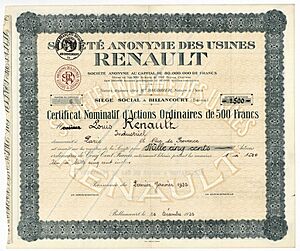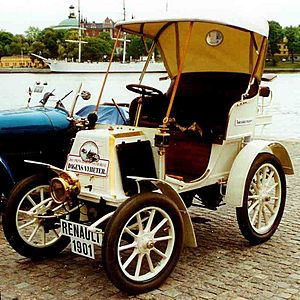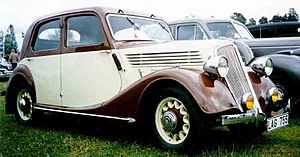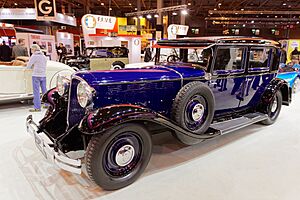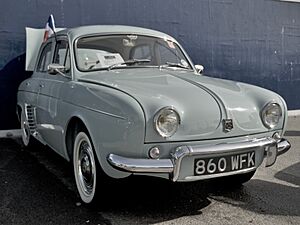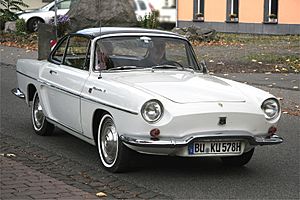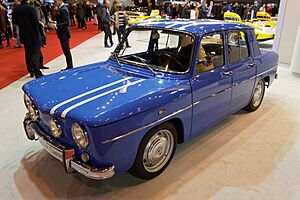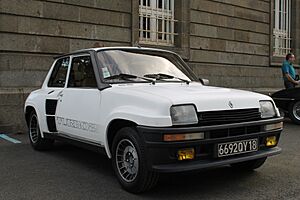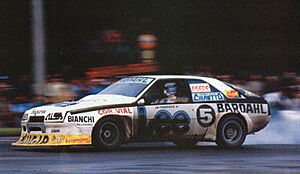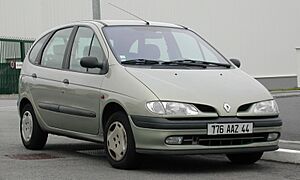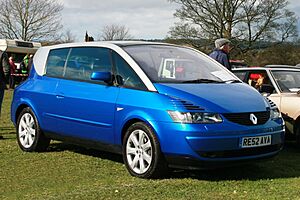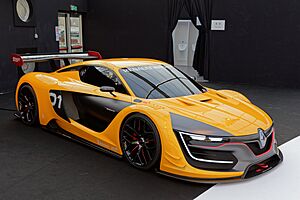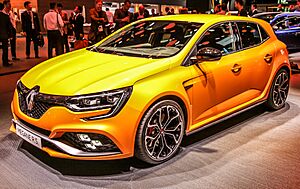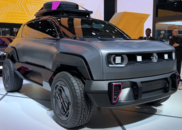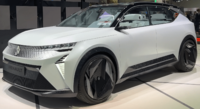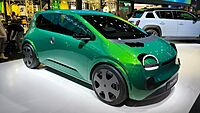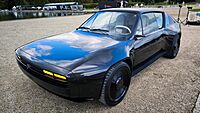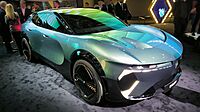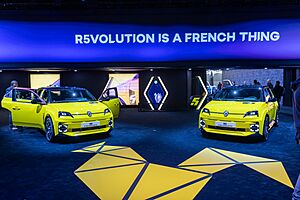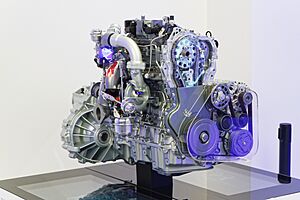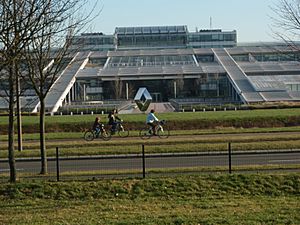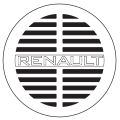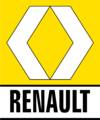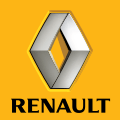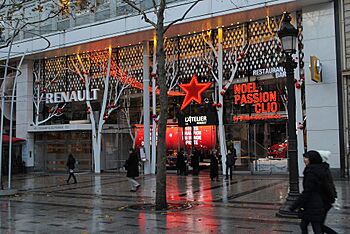Renault facts for kids
 |
|
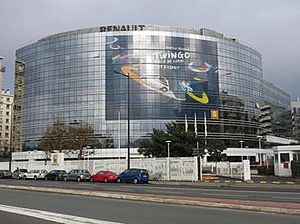
Headquarters in Boulogne-Billancourt, France
|
|
|
Trade name
|
Renault Group |
|---|---|
|
Formerly
|
Société Renault Frères (1899–1944) Régie Nationale des Usines Renault (1944–1990) |
| Public | |
| Traded as | Euronext Paris: RNO CAC 40 component |
| Industry | Automotive |
| Founded | 25 February 1899 |
| Founders |
|
| Headquarters |
,
France
|
|
Area served
|
Worldwide; 128 countries |
|
Key people
|
|
| Products |
|
| Brands | |
|
Production output
|
|
| Revenue | |
|
Operating income
|
|
| Total assets | |
| Total equity | |
| Owners |
|
|
Number of employees
|
170,158 (Q4 2020) |
| Subsidiaries |
List
Transportation
Renault SAS |
 |
|
| Owner | Renault S.A. |
|---|---|
| Introduced | December 1898 |
Renault S.A., often called Groupe Renault, is a French company that makes cars. It was started in 1899. Today, Renault makes many different cars and vans. In the past, they also made trucks, tractors, tanks, buses, airplanes, and even train vehicles.
Renault's main office is in Boulogne-Billancourt, near Paris, France. The Renault Group includes the Renault brand, plus other brands like Alpine, Dacia from Romania, and Mobilize. Since 1999, Renault has been part of the Renault–Nissan–Mitsubishi Alliance. The French government and Nissan each own 15% of the company.
Renault also owns other companies like RCI Banque (which helps people finance cars) and Renault Retail Group (which sells cars). They also have partnerships with other companies, like Horse Powertrain for engines and Oyak-Renault for manufacturing in Turkey. Renault is also famous for its involvement in motor sport, especially rallying and Formula 1.
Contents
- History of Renault
- How Renault Started (1898–1918)
- Between the World Wars (1919–1938)
- World War II and Aftermath (1939–1944)
- Renault's Comeback (1945–1971)
- The Modern Era (1972–1980)
- Changes and Growth (1981–1995)
- Becoming a Private Company and Alliances (1996–2019)
- COVID Effects and Company Changes (2019–Present)
- Renault's New Ideas
- Motorsport and Racing
- Renault's Money Matters
- Car Production
- How Renault is Managed
- Renault's Products and Technologies
- How Renault Cars are Designed
- Renault's Partnerships
- Awards Renault Has Won
- Marketing and Branding
- See also
History of Renault
How Renault Started (1898–1918)

The Renault company began on February 25, 1899. It was founded by Louis Renault and his brothers, Marcel and Fernand. Louis was a talented engineer who had already built several car designs. His brothers were good at business. Louis focused on designing and making cars, while Marcel and Fernand handled the business side.
The very first Renault car, the Renault Voiturette 1CV, was sold on December 24, 1898. Louis's father's friend bought it after a test drive.
In 1903, Renault started making its own engines. Before that, they bought them from another company. A big sale happened in 1905 when a taxi company bought Renault AG1 cars to create a taxi fleet. These taxis were later used by the French military during World War I. They became known as "Taxi de la Marne." By 1907, many taxis in London and Paris were made by Renault. Renault was also a top-selling foreign car brand in New York in 1907 and 1908. In 1908, the company made 3,575 cars, becoming France's largest car maker.
The Renault brothers knew that car races could make their cars famous. Renault became well-known by winning early city-to-city races in Switzerland, which helped sales grow fast. Both Louis and Marcel raced their company's cars. Sadly, Marcel died in an accident during the 1903 Paris-Madrid race. Louis stopped racing after that, but his company stayed involved in motorsports. For example, Ferenc Szisz won the first Grand Prix motor racing event in a Renault AK 90CV in 1906.
Louis took full control of the company in 1906 when Fernand retired due to health. Fernand passed away in 1909, and Louis became the only owner. He then changed the company's name to Société des Automobiles Renault.
Renault was known for new ideas from the very beginning. Back then, cars were luxury items not made on assembly lines. The smallest Renaults cost 3000 francs, which was about ten years' pay for an average worker. In 1905, the company started using mass production methods. In 1911, Louis Renault visited Henry Ford's factory and learned about their manufacturing ideas.
Before World War I, Renault made buses and commercial trucks. Their first real commercial truck came out in 1906. Renault also made important aircraft engines. They started in 1907 with air-cooled V8 engines. In 1911, the Renault 90 hp became the world's first V12 aircraft engine.
During World War I, Renault started making ammunition and military vehicles, like the important Renault FT tank. They also made many more airplane engines. Other companies, like Rolls-Royce, even made Renault engines under license. Renault's military designs were so successful that Louis received an award for his company's help.
Between the World Wars (1919–1938)
After World War I, Louis Renault expanded the company to make farm and industrial machinery. The war led to many new products. The first Renault tractor, the Type GP, was made from 1919 to 1930 and was based on the FT tank. Renault found it hard to compete with popular, affordable small cars. Problems with the US stock market and workers also slowed the company's growth. Renault also needed better ways to sell its cars. In 1920, Louis signed one of his first sales deals with Gustave Gueudet.
Older Renault cars had a unique front shape because the radiator was placed behind the engine. This continued into the 1920s. By 1930, all models had the radiator at the front. The car badge changed from a circle to the diamond shape we know today in 1925.
Renault introduced new models at the Paris Motor Show each year. This sometimes caused confusion about model years. For example, a "1927" model was mostly made in 1928.
During this time, Renault made two main types of cars: economy models with four-cylinder engines (called "Quatre" in the 1930s) and luxury models with six-cylinder engines (called "-six," later "Stella"). In 1928, Renault made 45,809 cars across seven models. The smaller cars were the most popular.
Renault's London operations were important in 1928. The UK market was large, and luxury cars were also sent to North America. Cars sold abroad often had special features like higher suspensions and better cooling. However, exports to the US dropped almost to zero after World War I. A luxury Renault car in the US could cost as much as a Cadillac.
Renault cars were built to be strong and reliable. The Renault Vivasix, an "executive sports" model from 1927, had a light steel body and a 3.18-liter six-cylinder engine. This design was used until World War II.
The "de Grand Luxe Renaults," which were very long cars, were made in small numbers. These cars were very stable, especially at high speeds.
The straight 8-cylinder Reinastella was introduced in 1929. It grew into a range that ended with the 1939 Suprastella. Many parts of these luxury Renaults, like engines and body panels, were made from aluminium.
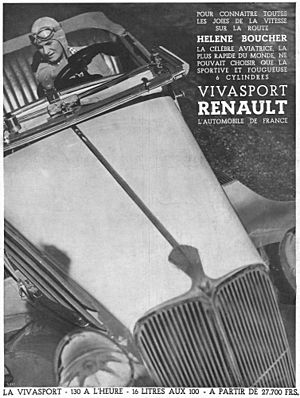
In 1928, Renault improved its "Stella" line. These cars had better interiors and a small star above the front logo. This idea was very popular, and in the 1930s, all cars used the "Stella" name.
In 1931, Renault started using diesel engines in its commercial vehicles.
Renault continued to make airplane engines after World War I. In the late 1920s, they tried to make a powerful military engine, but it wasn't very successful. However, their engines for civilian planes did better. In the 1930s, the company took over the airplane maker Caudron. They focused on small planes, invested in Air France, and helped start the airmail company Air Bleu. Renault Caudron planes set several speed records in the 1930s. Renault also kept developing tanks for France's military, like the D1 and the R 35.
In the late 1920s and early 1930s, Citroën became the largest car maker in France, making more modern and popular cars than Renault. But by the mid-1930s, the Great Depression hit French car makers hard. Renault could manage because of its tractor, railroad, and military businesses. Citroën went out of business and was bought by Michelin. Renault then became the largest car maker again, a position it held until the 1980s.
The Great Depression finally affected Renault in 1936. The company separated its airplane engine and foundry divisions, keeping its main car business. From 1936 to 1938, there were many worker disagreements and protests in the French car industry. Renault handled these issues very strictly, and over 2,000 people lost their jobs.
World War II and Aftermath (1939–1944)
During World War II, Renault's factories were controlled by the Germans. On March 3, 1942, British planes bombed the main Renault plant near Paris, causing a lot of damage. More bombings happened in 1943.
After Paris was freed in September 1944, the Renault factory slowly reopened. The French government decided to take control of the Renault factories. A resistance leader named Pierre Lefaucheux was put in charge.
Meanwhile, Louis Renault faced accusations after the war. He was arrested on September 23, 1944, and sadly passed away in October 1944 before his trial.
On January 1, 1945, the French government officially took over the company from Louis Renault. It was renamed Régie Nationale des Usines Renault. Renault's factories were the only ones permanently taken over by the French government. The Renault family tried to get the company back and receive money, but the courts said they could not change the government's actions.
Renault's Comeback (1945–1971)
Under Pierre Lefaucheux's leadership, Renault grew again. During the war, Louis Renault had secretly developed the rear engine 4CV car, which was launched in 1946. Renault also introduced its larger car, the Renault Frégate (1951–1960). The 4CV was very popular, selling over half a million cars until 1961.
After the 4CV's success, Lefacheux continued to develop new cars, even though the government wanted Renault to only make trucks. He oversaw the creation of the Dauphine. The Dauphine sold well as the company expanded its sales to other countries, including Africa and North America. Renault also sold the Renault Caravelle roadster.
In the 1950s, Renault bought two smaller French truck makers and combined them with its own truck and bus division in 1955 to form Saviem.
Renault then launched two more successful cars: the Renault 4 (1961–1992), a practical car like the Citroën 2CV, and the rear-engined Renault 8. The larger Renault 10 followed the Renault 8. The company also succeeded with the modern Renault 16, a pioneering hatchback launched in 1966, followed by the smaller Renault 6.
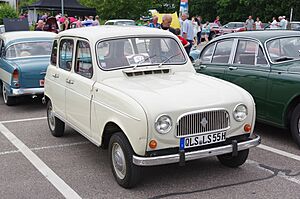
On January 16, 1970, Renault celebrated 25 years since it became a nationalized company. The 1960s were a time of strong growth. In October 1969, Renault launched the Renault 12, which was a very successful car. In 1970, Renault made over a million cars in a single year for the first time.
The Modern Era (1972–1980)
The company's small and fuel-efficient Renault 5 model, launched in January 1972, was another big success. The Renault 18 was introduced in 1978, and the larger Renault 20 in 1975.
In the mid-1970s, Renault expanded into more industries and continued to grow worldwide. The energy crisis made Renault try to enter the North American market again. Renault had some success in the US in the late 1950s, but then started to disappear from North America.
Renault bought a large share of Automobiles Alpine in 1973. Over the years, Renault also worked closely with American Motors Corporation (AMC). From 1962 to 1967, Renault assembled AMC cars in its factory in Belgium. Renault didn't have large luxury cars, so the "Rambler Renault" was offered as an alternative. Later, Renault continued to make and sell a car called the Renault Torino in Argentina. Renault also partnered with AMC on other projects, like a special engine in the late 1960s.
In the late 1960s and 1970s, the company set up branches in Eastern Europe, like Dacia in Romania, and South America. They also made technology agreements with Volvo and Peugeot to develop engines together.
In the mid-1960s, Renault Australia was set up and produced various models. This unit closed in 1981.
When Peugeot bought Citroën, their work with Renault was reduced. However, existing joint projects continued. In 1974, Citroën sold its truck and bus maker Berliet to Renault. Renault combined it with its Saviem company in 1978 to create Renault Véhicules Industriels, which became the only French maker of heavy trucks. In 1976, Renault organized itself into four main areas: cars, finance, commercial vehicles, and other industrial businesses. In 1980, Renault made over 2 million cars and light commercial vehicles.
In North America, Renault partnered with American Motors Corporation (AMC) in 1979, buying a small share of the company. The first Renault car sold through AMC dealerships was the R5, renamed Renault Le Car. Jeep vehicles were helping AMC stay in business. When the market for 4x4 trucks dropped in 1980, AMC was in danger of going out of business. To protect its investment, Renault gave AMC money and gained a controlling share of the company. Renault changed some AMC leaders, and Jose Dedeurwaerder from Renault became President of AMC.
This partnership led to Jeep vehicles being sold in Europe. The Jeep XJ Cherokee might have been a joint project between AMC and Renault engineers. The Jeep also used parts from Renault. Renault's goal was to save money by using Renault's parts and engineering knowledge. This helped improve the AMC inline six engine, making it more powerful.
Renault's car sales in North America were not as successful as Jeep vehicles. This was because the second energy crisis ended, and people didn't want small, fuel-efficient cars as much. One successful car was the Renault Alliance (an American version of the Renault 9), which came out in 1983. It was made in AMC's factory in Wisconsin and won an award for "Car of The Year" in 1983.
Renault eventually sold AMC to Chrysler in 1987. Renault's chairman, Georges Besse, had been killed. The Renault Medallion (Renault 21 in Europe) was sold through Jeep-Eagle dealerships from 1987 to 1989. Renault stopped importing cars to the US after 1989. A new large car, the Eagle Premier, was developed during the AMC and Renault partnership.
In early 1979, Renault bought a 20% share in the truck maker Mack to sell light trucks through Mack's dealerships. By 1983, Renault increased its share in Mack to 44.6%.
In the late 1970s and early 1980s, Renault became more involved in motorsports, using new ideas like turbochargers in its Formula One cars. Renault's engines boss, Georges Douin, made sure turbocharged engines were used in many Renault cars starting in 1980. By 1984, 10% of all turbocharged European cars were Renaults. The company's car designs were also new in other ways. The Renault Espace was one of the first minivans and was very popular in Europe for the next 20 years. The second-generation Renault 5, the award-winning Renault 9, and the luxurious 25 were all released in the early 1980s. However, some cars had quality problems, like the Renault 14.
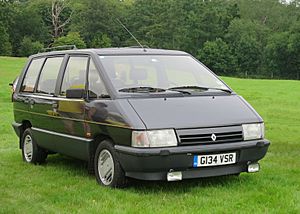
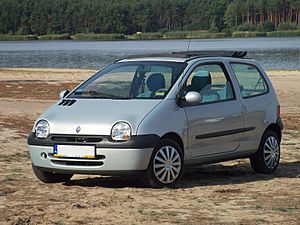
Changes and Growth (1981–1995)
Renault cars were successful on roads and in races. The 1984 Espace was Europe's first multi-purpose vehicle (MPV). However, Renault was losing a lot of money. The government stepped in, and Georges Besse became chairman. He cut costs by selling many of Renault's non-car businesses, reducing its involvement in motorsports, and letting go of many employees. This helped reduce the company's debt. Sadly, Besse was killed in November 1986. Raymond Lévy took over and continued Besse's plans, making the company financially stable by the end of 1987. Lévy decided to sell AMC to Chrysler that same year.
The Renault 9, a small family car, was voted European Car of the Year in 1981. It sold well in France but was later overshadowed by its sister car, the Renault 11 hatchback. The Renault 5 got a new design in 1984 and continued to sell well. The Renault 18 was replaced by the Renault 21 in 1986. Renault's most luxurious car in the 1980s was the Renault 25, launched in 1983.
In 1990, Renault worked more closely with Volvo to reduce costs for designing and buying car parts. Renault used Volvo's knowledge for bigger cars, and Volvo used Renault's designs for smaller and medium-sized cars. In 1993, the two companies planned to merge, but Volvo shareholders said no.
A stronger Renault launched successful new cars in the early 1990s. This included the Clio in May 1990, which replaced the Renault 5. The Clio was the first new model to use a name instead of a number. It won European Car of the Year and became one of Europe's best-selling cars. Other important new cars were the third-generation Espace in 1996 and the new Twingo in 1992. The Twingo was the first car marketed as a city car MPV and was very roomy for its size. Twingo sales reached 2.4 million in Europe.
Becoming a Private Company and Alliances (1996–2019)
It was decided that being owned by the state was holding the company back. In 1994, plans to sell shares to the public were announced. Renault became a private company in 1996. This new freedom allowed the company to expand into markets in Eastern Europe and South America. In December 1996, General Motors Europe and Renault started working together to develop light commercial vehicles.
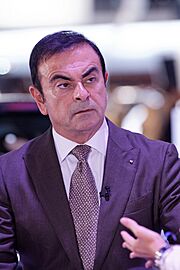
Renault still had financial challenges after becoming private. Renault's president, Louis Schweitzer, asked his deputy, Carlos Ghosn, to fix them. Ghosn created a plan to cut costs from 1998 to 2000. This involved reducing staff, changing how cars were made, making car parts more standard, and launching new models faster. The company also changed its organization, using a "lean production system" inspired by Japanese methods.
After Volvo left, Renault looked for a new partner. They talked with BMW, Mitsubishi, Nissan, and others. This led to a partnership with Nissan, which started on March 27, 1999. The Renault–Nissan Alliance was the first of its kind between a Japanese and a French company. Renault first bought a 36.8% share in Nissan. Nissan, in turn, bought a 15% share in Renault. Renault continued to operate on its own but worked with Nissan to reduce costs. In the same year, Renault bought a 51% share of the Romanian company Dacia. In 2000, Renault bought a controlling share of the South Korean Samsung Group's car division.
In Japan, Renault cars were sold by Yanase Co. But after Renault bought a share in Nissan in 1999, Nissan took over selling Renault cars in Japan.
In the late 1990s and early 2000s, Renault sold some of its businesses to help pay for its new investments and purchases. This helped them focus on making cars and vans. In 1999, they sold their automation company and engine parts division. In 2001, Renault sold its share in the bus maker Irisbus and its logistics company. After selling Renault Véhicules Industriels to Volvo in 2001, Renault kept a small share in the Volvo Group. In 2010, Renault reduced its share even more, and in 2012, they sold all their remaining shares. In 2004, Renault sold a 51% share in its farm machinery division to CLAAS. By 2008, CLAAS had full control.
In the 21st century, Renault became known for its unique and bold car designs. The second generation of the Laguna and Mégane had striking, angular designs that were successful. The 2000 Laguna was one of the first European cars with "keyless" entry and ignition. Some of Renault's more expensive models, like the Avantime and Vel Satis, did not sell as well. However, the design of these cars inspired the successful second-generation Mégane. Renault also became known for its car safety, earning high ratings from Euro NCAP. In 2008, Renault gained control of AvtoVAZ.
In April 2010, Renault–Nissan announced a partnership with Daimler. Renault provided Mercedes-Benz with a new 1.6-liter turbo-diesel engine, and Mercedes-Benz provided a 2.0-liter gasoline engine to Renault–Nissan. This new partnership also planned to develop a replacement for the Smart car based on the Twingo.
In February 2010, Renault opened a new factory near Tangier, Morocco. It could make 170,000 vehicles a year. It first made the Dacia Lodgy and Dacia Dokker models, followed by the Dacia Sandero in 2013. The factory's capacity increased to 340,000 vehicles per year. This factory is in a special trade area and is designed to have zero carbon emissions and liquid waste.
In the 2010s, Renault worked to gain more market share in China. In 2013, they formed a joint company with Dongfeng Motor Group called Dongfeng Renault. In December 2017, they signed a deal with Brilliance Auto to create a new joint company (Renault Brilliance Jinbei) to make light commercial vehicles. In December 2018, Renault announced it would buy a large share in JMCG's electric vehicle company JMEV. In July 2019, Renault took a 50% majority share of JMEV. In April 2020, Renault announced it planned to leave the Dongfeng Renault partnership.
In December 2012, Renault signed an agreement to build a factory near Oran, Algeria, to make Symbol cars starting in 2014. The Algerian government owns 51% of this factory.
In September 2013, Renault launched its brand in Indonesia, aiming to be a top European brand there by 2016.
In April 2015, the French government increased its share in Renault from 15% to 19.73% to prevent a vote that could reduce its control. In 2017, the government sold shares back and returned to a 15% stake.
In 2016, Renault changed its view on small diesel cars in Europe. They believed these cars would become too expensive to meet new pollution rules. In January 2017, Renault's shares dropped because French officials started an investigation into possible exhaust emissions issues. The company later recalled 15,000 cars for testing and fixing. Renault, like some other car companies, was accused of issues with measuring pollution from diesel cars. Renault denied any wrongdoing.
In November 2018, Renault's CEO Ghosn was arrested in Japan. Renault's shares fell after the news. After Ghosn resigned, Jean-Dominique Senard became chairman and Thierry Bolloré became CEO. In October 2019, Bolloré was fired and replaced by Clotilde Delbos as acting CEO. In January 2020, Renault named Luca de Meo as its new CEO, starting on July 1.
COVID Effects and Company Changes (2019–Present)
In May 2020, Renault announced a plan to cut costs by reducing 15,000 jobs worldwide. This was due to falling sales and the COVID-19 pandemic.
In January 2021, as part of a company update, Renault said it would divide its car division into four business units: Renault, Dacia and Lada, Alpine, and Mobilize (for new mobility services).
In April 2021, Renault reported that its revenue fell by 1.1% in the first three months of 2021. They planned to make fewer cars and focus on models that earn more money.
In November 2022, Renault announced plans to create a separate company for electric car development, called Ampère. They also planned to create a joint company called Horse with Geely for making engines (both gasoline and hybrid).
In January 2023, Renault said it planned to transfer almost 30% of its shares in Nissan to a French trust. This would reduce Renault's voting shares to 15% and give Nissan voting rights in Renault. The agreement also included Nissan investing in Ampere and other projects. Both companies approved these changes in February 2023. The share transfer was completed in November 2023.
In March 2025, Renault announced plans to buy Nissan’s 51% share in its Indian manufacturing unit.
In June 2025, Renault announced that Luca de Meo had resigned as its CEO.
Renault's New Ideas
- 1899: Louis Renault invented a new "direct drive" gear system that worked much better for going uphill.
- 1961: The Renault 4 was the first mass-produced car with a hatchback design.
- 1963: The Renault 8 was the first mass-produced car with a four-wheel disc brake system.
- 1980: Renault created the first patents for a "Braking distribution device for total adherence."
- 1982: The Renault Fuego was the first mass-produced car with keyless entry.
- 1988: CARMINAT, a system for real-time location and weather, was introduced. These ideas are now part of Renault's modern navigation systems.
- 2000: The Renault Laguna was one of the first European cars to have "keyless" entry and ignition.
Motorsport and Racing
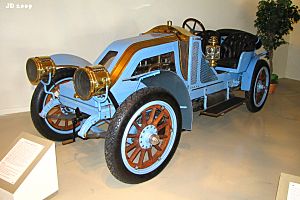
Renault started racing cars in the early 1900s, encouraged by Marcel Renault's interest in racing. Over the years, they bought companies known for racing, like Gordini and Alpine.
In the 1970s, Renault created a special racing division called Renault Sport. In 1978, they won the 24 Hours of Le Mans race with the Renault Alpine A442. Renault has also been very successful in rallying and Formula One racing.
The company has also supported racing series for young drivers, like Formula Renault and the Formula Renault 3.5. Many Formula One champions, like Fernando Alonso and Lewis Hamilton, started their careers in these races.
Renault Sport designs and makes the sporty Renault Sport cars, like the Renault Clio RS and the Renault Mégane RS. These cars hold world records on famous race tracks.

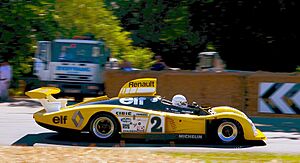
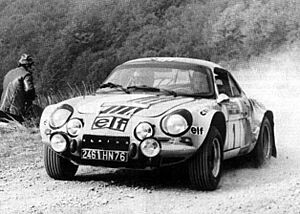
Formula One Racing
Renault brought the turbo engine to Formula One racing when their first car, the Renault RS01, debuted in 1977. The Renault team raced until 1986. From 1989, Renault supplied engines for the very successful Williams-Renault cars.
Renault took over the Benetton Formula team in 2000 and renamed it Renault F1 in 2002. In 2005 and 2006, the team won the Constructors' and Drivers' titles with Fernando Alonso.
Renault engines powered the winning 2010 Red Bull Racing team. In December 2010, Renault sold its final share in its old team, ending its direct role in running a Formula One team for the second time.
Renault bought the Enstone-based team for the 2016 season and renamed it Renault. In 2021, the team was renamed Alpine F1 Team and became part of the new Alpine business unit, with Renault still providing the engines. Renault will stop making F1 engines at Viry-Châtillon after the 2025 season.
Rallying Races
Renault has been involved in rallying from early on. Marcel Renault won the 1902 Rallye Paris-Vienna.
In the 1950s and 1960s, Renault made small cars that were good for rallying, like the 4CV, R8, and Dauphine. The tuner Amedee Gordini helped improve their performance. The Renault Dauphine won several international rallies, including the 1956 Mille Miglia and the 1958 Monte Carlo Rally.
In 1973, Renault took control of Automobiles Alpine, which made successful rally cars like the A110. A highly improved A110 won the first World Rally Championship, representing Alpine-Renault.
In 1976, Alpine's racing department and the Gordini factory were combined into Renault Sport. The focus shifted to Formula One, but Renault still won several rallies, including the 1981 Monte Carlo Rally with the Renault 5 Turbo, before leaving world rallying in late 1994.
Renault cars also take part in cross-country races, especially the Dakar Rally. The Marreau brothers won the 1982 race driving a Renault 20 Turbo 4x4 prototype.
Renaults have won the European Rally Championship four times.
Renault's Money Matters
| Year | 2013 | 2014 | 2015 | 2016 | 2017 | 2018 | 2019 | 2020 | 2021 | 2022 | 2023 |
|---|---|---|---|---|---|---|---|---|---|---|---|
| Revenue | 40.932 | 41.055 | 45.327 | 51.243 | 58.770 | 57.419 | 55.537 | 43.474 | 41.659 | 46.328 | 52.376 |
| Net income | 0.695 | 1.998 | 2.960 | 3.543 | 5.210 | 3.302 | -141 | -8.046 | 967 | -0.716 | 2.315 |
| Assets | 74.992 | 81.551 | 90.605 | 102.103 | 109.943 | 114.996 | 122.171 | 115.737 | 113.740 | 118.319 | 121.913 |
| Employees | 121,807 | 117,395 | 120,136 | 124,849 | 181,344 | 183,002 | 179,565 | 170,158 | 156,466 | 105,812 | 105,497 |
Car Production
Where Renault Cars are Sold
| Top 10 Groupe Renault vehicle sales by country, 2023 |
|||
|---|---|---|---|
| Rank | Location | Vehicle sales |
Market share |
| 1 | 551,373 | 25.6% | |
| 2 | 187,249 | 10.6% | |
| 3 | 176,963 | 14.4% | |
| 4 | 156,729 | 5.0% | |
| 5 | 134,398 | 12.3% | |
| 6 | 126,203 | 5.8% | |
| 7 | 102,980 | 4.6% | |
| 8 | 62,771 | 10.5% | |
| 9 | 61,445 | 38.1% | |
| 10 | 60,290 | 37.3% | |
| 11 | 51,790 | 12.2% | |
| 12 | 49,557 | 9.2% | |
| 13 | 48,321 | 1% | |
| 14 | 43,779 | 3.2% | |
| 15 | 39,688 | 9% | |
How Many Vehicles are Produced
Here's how many vehicles were made in Renault group factories in 2023:
| Location | Vehicles Produced (units) |
|---|---|
| Mioveni (Romania) | 322,086 |
| Tangier (Morocco) | 287,860 |
| Bursa (Türkiye, Oyak Renault) | 284,040 |
| Curitiba (Brazil) | 178,332 |
| Valladolid (Spain) | 172,733 |
| Batilly (France, SoVAB) | 150,260 |
| Sandouville (France) | 131,426 |
| Palencia (Spain) | 129,567 |
| ElectriCity Maubeuge (France, Ampere) | 123,149 |
| Busan (South Korea, Renault Korea) | 100,503 |
| Casablanca (Morocco) | 94,801 |
| Córdoba (Argentina) | 83,586 |
| Chennai (India, RNAIPL) | 67,266 |
| Novo Mesto (Slovenia) | 60,881 |
| Shiyan (eGT-NEV, partner in China) | 54,119 |
| ElectriCity Douai (France, Ampere) | 51,486 |
| Bursa (Türkiye, with Karsan) | 41,327 |
| Envigado (Colombia) | 34,712 |
| Flins (France) | 16,679 |
| Dieppe (France, Alpine) | 4,708 |
| Oran (Algeria) | 2,456 |
| Total | 2,391,977 |
Engine Production
Here's how many engines were made in Renault group factories in 2023:
| Location | Engines Produced (units) |
|---|---|
| Valladolid (Spain) | 969,502 |
| Cléon (France) | 665,129 (thermal + electric) |
| Mioveni (Romania) | 345,121 |
| Curitiba (Brazil) | 217,866 |
| Bursa (Türkiye) | 210,754 |
| Busan (South Korea) | 96,527 |
| Total | 2,504,899 |
Gearbox Production
Here's how many gearboxes were made in Renault group factories in 2023:
| Location | Gearboxes Produced (units) |
|---|---|
| Seville (Spain) | 596,576 |
| Cacia (Portugal) | 526,627 |
| Mioveni (Romania) | 278,509 |
| Cléon (France) | 239,990 |
| Los Andes (Chile) | 189,529 |
| Bursa (Türkiye) | 71,895 |
| Total | 1,903,126 |
How Renault is Managed
Renault's main office is in Boulogne-Billancourt, France. This location is close to the original Renault factories, showing the company's long history there.
Renault is managed by a board of directors, an executive committee, and a management committee. As of January 2019, the board includes people like Jean-Dominique Senard (chairman), Cherie Blair, and Catherine Barba. Clotilde Delbos was the acting CEO.
Renault's Products and Technologies
| Rank | Model | Sales |
|---|---|---|
| 1 | Dacia/Renault Sandero | 308,781 |
| 2 | Renault Clio | 295,325 |
| 3 | Dacia/Renault Duster | 256,722 |
| 4 | Renault Captur | 159,562 |
| 5 | Renault Trafic | 128,041 |
| 6 | Renault Kwid | 112,472 |
| 7 | Renault Master | 107,005 |
| 8 | Renault Trafic | 106,400 |
| 9 | Dacia Jogger | 94,128 |
| 10 | Renault Megane | 87,614 |
Current Car Models
Here are some of the cars Renault makes today, with the year they were introduced:
- Espace (1984–present; crossover)
- Clio (1990–present; hatchback)
- Mégane E-Tech Electric (2021–present; crossover)
- Kangoo (1997–present; also sold as Mercedes-Benz Citan and Nissan Townstar)
- Kardian (2024-present; crossover)
- Captur (2013–present; crossover)
- Duster Oroch (Latin America only) (2015–present; pick-up)
- Kwid (2015–present; hatchback)
- Alaskan (2016–present; pick-up)
- Triber (2019–present; mini MPV)
- Arkana (2019–present; crossover)
- Kiger (2021–present)
- Taliant (2021–present; a redesigned Dacia Logan)
- Austral (2022–present; crossover)
- Espace (2023-present; crossover)
- Rafale (2024–present; crossover coupé)
- Scenic E-Tech (2024–present; crossover)
- Symbioz (2024–present; crossover)
- 5 E-Tech (2024–present; hatchback)
- 4 E-Tech (2025–present; crossover)
Dacia vehicles, sold in some places as Renault:
- Duster (2009–present)
Renault Samsung vehicles, sold in some places as Renault:
- Koleos (2008–present; Renault Samsung QM5/Renault Samsung QM6)
- Arkana (2020–present; Renault Samsung XM3)
Renault light commercial vehicles (vans and small trucks):
- Master (1980–present; also sold as Nissan Interstar)
- Trafic (1980–present; also sold as Nissan Primastar)
- Kangoo (1997–present; also sold as Mercedes-Benz Citan and Nissan Townstar)
- Express (2021–present; also sold as Mercedes-Benz Citan and Nissan Townstar)
Dacia light commercial vehicles, sold in some places as Renault:
- Duster Commercial (2017–present)
Concept Cars
Renault concept cars are special designs that show what future cars might look like and what new technologies they might have. Since 2008, Renault has shown many all-electric car concepts called "Z.E." (for zero emission).
Renault showed a hybrid car concept called the Ondelios in 2008. In September 2014, Renault presented a new hybrid car, the Eolab, which had many new ideas that the company planned to use in cars by 2020.
In 2014, at the New Delhi Auto Show, Renault announced a new concept car, the Kwid Concept, which came with a helicopter drone.
Electric Vehicles
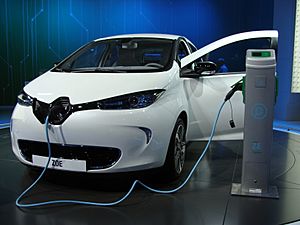
In 2013, Renault became the top seller of electric vehicles in Europe. This was thanks to its wide range of electric cars like the Twizy, Zoe, Fluence, and Kangoo. The Renault Zoe was Europe's best-selling all-electric car in 2015 and 2016. Global Zoe sales reached 50,000 units by June 2016 and 150,000 units by June 2019. Groupe Renault's total electric vehicle sales passed 100,000 units in September 2016. By December 2019, the Group had sold over 273,550 electric vehicles worldwide.
Starting in 2008, Renault made agreements for its planned zero-emission cars with countries and regions like Israel, Portugal, Denmark, and the US states of Tennessee and Oregon.
We want to introduce cars that produce no pollution as quickly as possible. This helps people get around even with high oil prices and protects the environment.
According to Carlos Ghosn, the Renault–Nissan alliance was very important for developing electric cars. He said they needed each other for things like making batteries, setting up charging stations, and planning their business.
I don't think either Renault or Nissan could have successfully launched an electric car alone. You can have an electric car alone. But you can't have a complete electric car business system, from batteries to recycling to cars to charging stations, by being alone.
The Renault–Nissan group is part of the PHEV Research Center. In September 2013, Renault and Bolloré announced they would work together on a new electric vehicle and a car-sharing project.
In 2021, Renault launched a new electric vehicle and mobility brand called Mobilize. They showed a small electric car prototype called the EZ-1. Renault Group also invested in a new company called Verkor, which plans to develop electric vehicle batteries and build a large factory in France by 2026.
By 2025, Renault plans to produce 400,000 electric vehicles each year.
Eco² Cars
In 2007, Renault introduced a new line of environmentally friendly cars called eco². These cars used at least 5% recycled plastic, and 95% of their materials could be reused. Eco² cars also had low CO2 emissions or could use biofuel. Renault received an Environment Award in 2008 for its impressive range of low-emission vehicles.
Self-Driving Cars
Renault plans to introduce autonomous vehicle (self-driving) technology by 2020. The company showed a prototype called the Next Two (based on the Zoe) in February 2014.
How Renault Cars are Designed
Car Design Process
Early Design
In its early years, Renault only made the car's chassis (frame), and other companies added the bodywork. The first car with a Renault-made body was the "Taxi de la Marne" in 1905. Most early Renault bodies were simple and practical until the Reinastella was shown in 1928. In the 1930s, Renault designed sleek cars like the Viva Grand Sport. In the 1950s, the company worked with designers from Ghia.
Renault Styling Department
In 1961, Renault created its own design department called Renault Styling. It was led by Gaston Juchet starting in 1963. In 1975, Robert Opron became the chief designer, and Renault Styling was divided into groups for interiors, exteriors, and advanced designs.
In the 1960s, a computer system called UNISURF was introduced to help with design and manufacturing. This system was led by Pierre Bézier, who is famous for Bézier curves.
Industrial Design Department
In 1987, Renault named Patrick le Quément as chief designer and created the Industrial Design Department. This new department used more technology and staff. Renault gave it the same importance as engineering and product planning.
Le Quément was known for bold designs like the Mégane II and the Vel Satis, which gave Renault a more consistent and stylish look. In 1995, Design and Quality departments were combined under le Quément. Later, the new department moved to the Technocentre, which also became the base for engineering and product planning. The design group was organized into three parts: Car Design, Truck/Van/Bus Design, and Concept Cars/Advanced Design. Over the next few years, design centers opened in other countries like Spain, South Korea, Romania, India, Brazil, and China.
At the end of 2009, Laurens van den Acker replaced le Quément. He introduced the "cycle of life" idea to Renault's design.
Engineering and Planning
Most of Renault's engineering was spread out until 1998, when the Technocentre became the main engineering facility. There are still other engineering centers, like Renault Technologies Americas (in North and South America) and Renault Technologies Romania (in Europe and Turkey). As of 2013, Renault's engineering section had over 6,500 employees worldwide. Engine development is handled by a special division called Renault Powertrains.
As of 2014, Engineering and Product Planning were led by Gaspar Gascon Abellan and Philippe Klein.
The Technocentre
The Renault Technocentre is the main place for research and development. It is located in Guyancourt, France. It covers a large area and brings together all the departments involved in developing products and manufacturing processes, including design, engineering, and product planning. It also has representatives from suppliers. The Technocentre has more than 8,000 employees. It has three main parts: The Advance Precinct (for early design), The Hive (for research and engineering), and the prototype build center.
The Technocentre was one of the first places to use real-time, life-size 3D modeling systems.
Renault Tech
Renault Tech is a part of Renault Sport Technologies. It is based in Les Ulis, France. It was started in 2008 and is responsible for changing cars and vans for special uses, like cars for people with disabilities, driving school cars, or vehicles for businesses.
Renault's Partnerships
Companies Renault Owns
Regional Brands
Dacia
In 1999, Renault bought a 51% share of the Romanian car maker Automobile Dacia. Later, this share increased to 99.43%. Dacia is now part of the Renault group and makes affordable cars mainly for Europe and Northern Africa. Many Dacia models are similar to Renault models.
RCI Banque
RCI Banque is a company fully owned by Renault. It provides financial services for Renault brands around the world and for Nissan brands in Europe, Russia, and South America.
Renault Retail Group
Renault Retail Group is Renault's own car sales company for Europe. It operates in many European countries.
Manufacturing Factories
French Factories
|
|
Factories Outside France
|
|
Partnerships with Other Companies
Renault–Nissan–Mitsubishi Alliance
For many years, Renault owned a large share of Nissan, giving it control. Nissan also owned a share in Renault. As of November 2023, Renault owns 15% of Nissan with voting rights.
Besides sharing engines and working together on zero-emission technology, Nissan increased its presence in Europe by selling some Renault van models under the Nissan brand. Some passenger cars have also been rebranded, like the Renault Clio-based Nissan Platina in Brazil. The "Renault Production System," used by all Renault factories, learned a lot from the "Nissan Production Way," which helped Renault make cars more efficiently.
In March 2010, the Renault-Nissan alliance opened its first joint factory in Chennai, India. This factory builds the Nissan Micra. The Renault Fluence and Renault Koleos are also assembled there. Because of this new factory, Renault ended its partnership with Mahindra & Mahindra in India.
Renault–Nissan–Mitsubishi and Daimler Alliance
On April 7, 2010, Renault and Nissan announced a partnership with Daimler AG. Daimler bought a small share in Renault-Nissan, and Renault and Nissan each bought a small share in Daimler.
Geely Alliance
In January 2022, Renault and the Chinese company Geely agreed that Renault's South Korean company, Renault Korea, would make cars based on Geely's car platform. These cars were first meant for the South Korean market. In December 2022, Geely bought a 34% share of Renault Korea as part of their partnership. Renault still owns most of the company.
In May 2024, Renault and Geely created a joint venture company to make powertrains, which include gasoline engines and hybrid systems. This partnership started with an agreement in November 2022. Geely and Renault plan to share their knowledge for engines and hybrid systems. They also plan to supply engines to other car brands like Dacia, Volvo, Lynk & Co, Proton, as well as Nissan and Mitsubishi Motors from the Renault–Nissan–Mitsubishi Alliance.
In June 2025, Renault, Geely Auto and Geely Holding announced they would create a joint company to make electric vehicles in Brazil. This new company will be mostly owned by Renault. It will make and sell cars under the Renault and Geely brands in Brazil, sharing sales networks.
American Motors Partnership
In 1979, Renault made a deal with American Motors Corporation (AMC) to sell cars in the US. A year later, Renault bought a 22.5% share in AMC. This wasn't their first time working together; in the early 1960s, Renault assembled and sold Rambler cars in France. In 1982, Renault increased its share in AMC to 46.4%. The Renault Alliance/Encore (a changed version of the Renault 9 and 11) started being made in the US. But because AMC continued to struggle, Renault left the US market in 1987 and sold its share to Chrysler.
Awards Renault Has Won
Renault models have won the European Car of the Year award eight times:
- 1966: Renault 16
- 1982: Renault 9
- 1991: Renault Clio
- 1997: Renault Scénic
- 2003: Renault Mégane II
- 2006: Renault Clio III
- 2024: Renault Scenic E-Tech
- 2025: Renault 5 E-Tech
Renault cars have also won many awards in different countries like Spain, Australia, Ireland, and the United States. Renault and its Dacia brand have won three "Autobest" car of the year awards.
In 2016, Renault received an award for its Art Collection, which inspired its car designers.
Marketing and Branding
Renault sells its products under the brands Renault, Dacia, and Alpine. In 2021, Renault started the Mobilize brand, which began selling electric mobility services and vehicles in 2024.
The Renault Badge
Renault's first badge in 1900 had the Renault brothers' initials. When they started making cars in large numbers in 1906, they used a gear-shaped logo with a car inside. After World War I, the company used a logo with an FT tank. In 1923, they introduced a new circle-shaped badge, which was replaced by the "diamond" or lozenge shape in 1925. The diamond shape shows the brand's strong and consistent image.
The Renault diamond logo has changed many times. To make its image more modern, Renault asked Victor Vasarely to design a new logo in 1972. This new logo kept the diamond shape. The design was later updated to match the rounder shapes of Renault's new cars. The current badge has been used since 1992.
The logo for websites and print has been updated several times. In 2002, a more realistic version inside a yellow rectangle was made. In 2004, the logo got a new font called Renault Identité. In 2007, a version with the name and logo inside a square was created.
In April 2015, Renault introduced new designs to show the difference between the company and the car brand. This was part of their 'Passion for life' campaign. The new brand logo replaced the yellow background with a yellow stripe. A new font was also introduced. A company logo was shown in 2015, including Renault, Dacia, and Renault Samsung Motors.
In January 2021, a new flat diamond logo was introduced with the Renault 5 Prototype electric concept car. People liked this logo so much that Renault officially made it their new symbol in March 2021. The first car with the new logo will be shown in 2022.
The yellow color linked with the company first appeared in the diamond badge in 1946, when Renault became a national company.
Renault's Fonts
Renault MN Font
Both the Renault logo and its documents (like technical manuals and ads) used Renault MN, a special font designed by a British company. This font was created to save money because using other fonts was expensive back then.
Renault Identité Font
In 2004, a French font designer was asked to create a new font. This new font, called Renault Identité, was shown in October of that year.
Helvetica Font
Since 2007, for all graphic advertising, Renault has used Helvetica Neue Condensed.
Renault Life Font
The Renault Life font family was created by Fontsmith Limited. It has six fonts in three different thicknesses.
L'Atelier Renault Paris
Renault's main showroom, L'Atelier Renault, is on the Champs-Élysées in Paris. It opened in November 2000. The first Renault place at this spot was the Magasin Renault in 1910, which was a very early car showroom.
L'Atelier has a Renault shop and often features exhibitions of Renault and Dacia cars. There's also a restaurant on the second floor with a view of the Champs-Élysées. The ground floor can hold up to five exhibitions at once. By March 2009, 20 million people had visited L'Atelier Renault.
Renault Classic Cars
Renault Classic is a special department within Renault that collects, protects, and shows important cars from the company's history. The collection was put together in 2002, and its workshops opened in 2003.
Music in Ads
In the 1980s and 1990s, Renault's European advertisements often used Robert Palmer's song "Johnny and Mary". They used the original song at first, and then different versions of the song were made for ads in the 1990s.
Sponsorships
Renault has sponsored films as a way to advertise since 1899. A Renault Voiturette Type A, driven by Louis Renault, appeared in one of the early films by the Lumière brothers. Between 1914 and 1940, the company ordered a series of documentary films to show its industrial work. Renault also supported some films set in Africa in the 1920s to show how reliable its cars were in tough conditions. Since 1983, the company has sponsored the Cannes Film Festival and other festivals like the Venice Film Festival and the BFI London Film Festival.
Through its foundations and institutes, Renault supports projects around the world that focus on education, road safety, and diversity.
See also
 In Spanish: Renault para niños
In Spanish: Renault para niños
- Tanks in France


